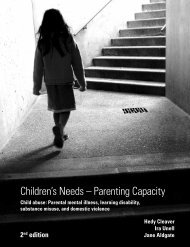British Sign Language and Linguistic Access Working Group ...
British Sign Language and Linguistic Access Working Group ...
British Sign Language and Linguistic Access Working Group ...
You also want an ePaper? Increase the reach of your titles
YUMPU automatically turns print PDFs into web optimized ePapers that Google loves.
■Few teachers in few services have any form of qualification in English-based signsystems. Yet there is widespread use of <strong>Sign</strong> Supported English (ie within the ‘T/Ca’<strong>and</strong> ‘T/Cb’. Services in table 7) <strong>and</strong> some reported use of <strong>Sign</strong>ed English. Thereappears to be a need for more study on the use of such systems in Scotl<strong>and</strong>: forexample, the extent to which the use of SSE may be related to limited availability ofadvanced levels of BSL training, rather than being a linguistic strategy. There alsoneeds to be guidance on relevant training <strong>and</strong> qualifications, appropriate to theapplication of the system as a specific strategy.7.2. QUALIFICATIONS OF OTHER PROFESSIONALS WORKING WITH DEAFPUPILS7.2.1. SCOPING STUDY SURVEY 2007 DATABSL qualificationsChart 6 shows the highest levels of BSL qualification of each type of professional, otherthan ToDs, who work with deaf pupils in schools. Registration status as a BSL/Englishinterpreter is classed as the highest level, although it also indicates additional skills ininterpreting (see Appendix 3).As with the data on ToDs, above, these data should be seen in the context of:■ The fact that information on current training was not specifically requested;■ The paucity of BSL training opportunities at advanced level.Bearing these factors in mind, the level of BSL qualification among staff is generally low,as it is with ToDs. Out of 173 staff:■■Two are registered BSL/English interpreters (one Communication Support Worker<strong>and</strong> one specialist nursery nurse);Eight have advanced level 3: a Learning Support Teacher; 2 Communication SupportWorkers; 3 Deaf Tutors; a specialist Nursery Nurse <strong>and</strong> an Educational Audiologist.The generally low levels have significance in relation to the relatively high numbers ofLearning Support teachers <strong>and</strong> assistants working with deaf pupils, as noted above, <strong>and</strong>especial significance for those working directly with pupils who use BSL. Of particularnote are the following details, which include additional relevant information on worksetting <strong>and</strong> language used:■■58% of the 37 Learning Support Teachers (excluding the 8 counted as ToDs) have noBSL qualifications. Of the twenty who work in schools for deaf children, eighteenhave levels 1 or 2 BSL qualification, <strong>and</strong> one has level 3. Among the seventeen whowork in other settings, none report that they are currently using BSL <strong>and</strong> three (18%)have basic levels (maximum level 2)77% (10) of the Communication Support Worker staff have maximum level 2 BSL.As at least 82% (14) use BSL to some extent in their work with deaf pupils, <strong>and</strong> arelikely to provide some amount of BSL/English interpretation, this is of concern. Thepercentage may actually be higher than this, as information on language was notprovided on the three remaining staff. See also later sections on CommunicationSupport Workers (sections 10.2.4 <strong>and</strong> 15.5)31
















